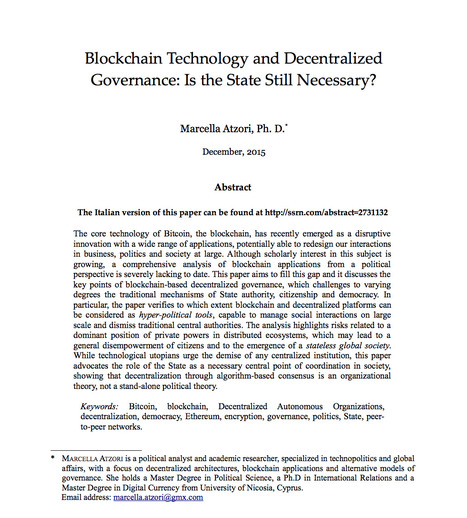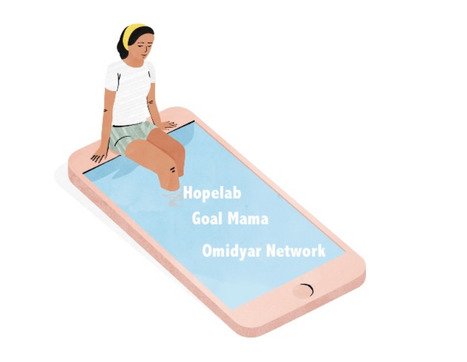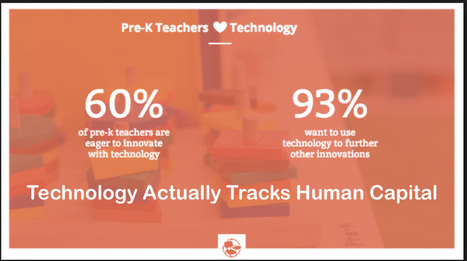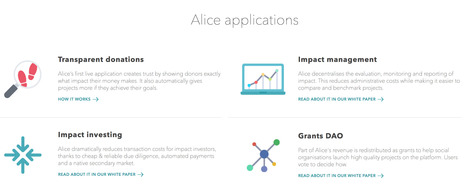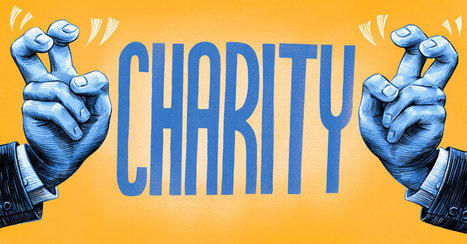 Your new post is loading...
 Your new post is loading...

|
Scooped by
Roxana Marachi, PhD
July 18, 2019 9:40 AM
|

|
Scooped by
Roxana Marachi, PhD
May 7, 2019 11:59 AM
|

|
Scooped by
Roxana Marachi, PhD
April 10, 2019 2:36 PM
|
By Gideon Greenspan "I’m not a fan of the term “smart contracts”. For a start, it has been used by so many people for so many different things, that we should probably just ban it completely. For example, the first known reference is from 1997, when Nick Szabo used it to describe physical objects that change their behavior based on some data. More recently, the term has been used for the exact opposite: to describe computation on a blockchain which is influenced by external events such as the weather. For now let’s put both of these meanings aside. I want to focus here on “smart contracts” in the sense of general purpose computation that takes place on a blockchain. This meaning was popularized by Ethereum, whose white paper is subtitled “A Next-Generation Smart Contract and Decentralized Application Platform”. As a result of the attention that Ethereum has received, this meaning has become the dominant one, with banks (and others) working away on smart contract proofs-of-concept. Of course, since we’re talking about regulated financial institutions, this is mostly in the context of private or permissioned blockchains, which have a limited set of identified participants. For reasons that are now well understood, public blockchains, for all of their genius, are not yet suited for enterprise purposes. So is the future bright for smart contracts in private blockchains? Well, kind of, but not really. You see: Smart contracts make for slow and clunky blockchains. If you know about the halting problem and understand how data dependencies prevent concurrency then you may already be convinced. But if not, make yourself a coffee, take a deep breath, and follow me down the rabbit hole… Understanding smart contracts In order to understand Ethereum-style smart contracts, we need to start with bitcoin, the first (and still most popular) public blockchain. The bitcoin blockchain was originally designed for one thing only: moving the bitcoin currency from one owner to another. But once it was up and running, people started embedding “metadata” in transactions to serve other purposes, such as digital assets and document notarization. While some bitcoiners fought these applications, an official mechanism for metadata was introduced in March 2014, with usage growing exponentially ever since. As well as projects built on the bitcoin blockchain, many next-generation public blockchains were developed and launched, including Nxt, Bitshares, Ripple and Stellar. These were designed from the ground up to support a broader range of activities, such as user-created assets, decentralized exchange and collateralized borrowing. Each of these blockchains has a different set of features, as decided upon by its developers, and each must be upgraded by all of its users when a new feature is added. Things started to get rather messy. Having been involved in some of these projects, Vitalik Buterin posed a simple but brilliant question: Instead of lots of application-specific blockchains, why not have a single public blockchain that can be programmed to do whatever we might want? This über-blockchain would be infinitely extendible, limited only by the imagination of those using it. The world of crypto-enthusiasts was almost unanimously convinced by this powerful idea. And so, with $18 million in crowd funding and to great excitement, Ethereum was born. Ethereum is a new public blockchain with an associated cryptocurrency called “ether”, like hundreds which came before it. But unlike other blockchains, Ethereum enables anybody to create a “contract” inside the blockchain. A contract is a computer program with an associated miniature database, which can only be modified by the program that owns it. If a blockchain user wants to change a database, they must send a digitally signed message to its contract. The code in the contract examines this message to decide whether and how to react. Ethereum contracts can be written in one of several new programming languages, such as Solidity and Serpent. Like most programming languages, these are Turing complete, meaning that they can express any general purpose computation. A key feature of Turing complete languages is the loop structure, which performs an operation repeatedly until some condition is fulfilled. For example, a loop might be used to print the numbers from one to a million, without requiring a million lines of code. For the sake of efficiency, programs written for Ethereum are compiled (i.e. converted) into more compact bytecode before being stored on the chain. Ethereum nodes then execute this bytecode within a virtual machine, which is essentially a simulated computer running inside a real one. When an Ethereum contract is created on the blockchain, it sets up the initial state of its database. Then it stops, waiting politely until it’s called upon. When a user of the blockchain (or another contract) sends it a message in a transaction, the contract leaps into action. Depending on the code within, it can identify the source of the message, trigger other contracts, modify its database and/or send back a response to the caller. All of these steps are performed independently on every node in the network, with identical results. To give an example, a simple Ethereum subcurrency contract maintains a database of user balances for a particular asset. If it receives a message to transfer funds from Alice to Bob, it will (a) check the message was signed by Alice, (b) check that Alice has sufficient funds, (c) transfer funds from Alice’s to Bob’s account in the database and (d) respond that the operation was successful. Of course, we don’t need Ethereum for that, because a simple bitcoin-style blockchain with native asset support can do the same thing. Ethereum really comes into its own for complex multi-stage business logic, such as crowdfunding, decentralized exchanges, and hierarchical governance structures. Or so, at least, the promise goes."... For full post, see: https://www.multichain.com/blog/2015/11/smart-contracts-slow-blockchains/

|
Scooped by
Roxana Marachi, PhD
April 8, 2019 9:12 PM
|
To access online, click here.

|
Scooped by
Roxana Marachi, PhD
April 8, 2019 2:15 AM
|

|
Scooped by
Roxana Marachi, PhD
April 5, 2019 7:17 PM
|
Abstract "Alice is a decentralized social impact network built on the Ethereum blockchain. It helps social organisations (charities, NGOs, social enterprises) to run projects transparently, using smart contract-based incentives to ensure their impact is independently verified and accessible to everyone. This makes it much easier for funders (philanthropic organisations, impact investors, small donors) to identify and scale social projects that demonstrably work, while reducing due diligence, reporting and other transaction costs. Alice’s first application is live at http://www.alice.si. Much of our code is open-source and available on our website in geek mode http://alice.si/geek-mode." __________________________ For more on Blockchain, see: http://bit.ly/Blockchain_Files

|
Scooped by
Roxana Marachi, PhD
March 30, 2019 1:40 AM
|
By Rob Price "Cryptocurrencies like bitcoin and Ethereum have long had a reputation as being somewhat of a "Wild West," beset by hype bubbles, scams, and hacks — and that seems unlikely to change any time soon. Amid the massive hype and speculation around Initial Coin Offerings (ICOs), $8 million (£6.1 million) was stolen from would-be investors in one startup. For the uninitiated, ICOs are a fancy new way of fundraising enabled by digital currencies like Ethereum— participants invest money and receive digital "tokens" in return. It's largely unregulated, and some observers believe the market is in a massive bubble — with some ICO crowdfunding events raising hundreds of millions of dollars. In the case of Coindash, its ICO was rapid — and disastrous. Motherboard reports that just minutes after it began, the company was forced to warn investors that their funds had been stolen due to a hack. The attacker(s) had apparently hacked into the website and changed the address that investors were sending their funds to — meaning the cash was funnelled directly to them. It's the digital equivalent of changing the name on the paperwork so investors make out their cheques to the wrong person — and it's basically irreversible."... For full story, visit: https://www.businessinsider.com/hackers-steal-8-million-ethereum-coindash-ico-2017-7

|
Scooped by
Roxana Marachi, PhD
December 12, 2019 9:04 PM
|

|
Scooped by
Roxana Marachi, PhD
February 17, 2019 8:24 PM
|
[From wrenchinthegears blog] "I’ve heard rumblings from folks in a number of states about pending legislation to establish home visit programs for expectant families or families with newborns or pre-school age children. So many families are struggling. Poverty is at an all time high. When hearing about such bills, those who have not been faced with the challenge of navigating impersonal bureaucracies, will likely think, “Thank goodness! Our elected officials are recognizing how hard things are and are stepping up to do something for those people.” For those who think that, I wish you were right, but the reality is considerably more troubling. I follow money, and it tells a different story. It tells the tale of a sweeping program of “collective impact” cultivated by consultancies like Third Sector Capital Partners, FSG, and the Nonprofit Finance Fund. Strive Together, a non-profit program incubated in Cincinnati, OH under the wing of Gates Foundation-funded Knowledgeworks (promoter of learning ecosystems), will carry out the program."... For full post, visit: https://wrenchinthegears.com/2019/02/17/home-visit-legislation-a-sales-pitch-for-family-surveillance/

|
Scooped by
Roxana Marachi, PhD
February 8, 2019 11:36 AM
|
[Selected quotes] ..."Creative Financing In 2013, Dallas hosted Commit's partner, Strive Cradle to Career Network, a subsidiary of KnowledgeWorks. Collective Impact movement takes center stage in Texas, Strive's Edmondson, Dallas Mayor Rawlings to speak during convening. A key luncheon plenary on September 26, titled, “Social Impact Bonds: How Civic Infrastructure Helps Sites Get Ready for Creative Financing,” will discuss ways communities can build civic infrastructure through social impact bonds, a creative financing tool where investment firms invest in the public sector to help solve complex social problems. Representatives from The United Way of Salt Lake City, Social Finance and Third Sector Capital Partners will discuss how they developed the nation’s first social impact bonds." They pretty much spelled it out. Creative financing. During Dallas Startup Week in 2015, Mayor Rawlings told the audience, "There's a lot of money to be made in education."... For full post, see: https://www.linkedin.com/pulse/collective-impact-where-public-public-private-lynn-davenport/

|
Scooped by
Roxana Marachi, PhD
June 1, 2018 9:00 PM
|
By Joanna Redden "There is growing consensus that with big data comes great opportunity, but also great risk. But these risks are not getting enough political and public attention. One way to better appreciate the risks that come with our big data future is to consider how people are already being negatively affected by uses of it. At Cardiff University’s Data Justice Lab, we decided to record the harms that big data uses have already caused, pulling together concrete examples of harm that have been referenced in previous work so that we might gain a better big picture appreciation of where we are heading. We did so in the hope that such a record will generate more debate and intervention from the public into the kind of big data society, and future we want. The following examples are a condensed version of our recently published Data Harm Record, a running record, to be updated as we learn about more cases. 1. Targeting based on vulnerabilityWith big data comes new ways to socially sort with increasing precision. By combining multiple forms of data sets, a lot can be learned. This has been called “algorithmic profiling” and raises concerns about how little people know about how their data is collected as they search, communicate, buy, visit sites, travel, and so on. Much of this sorting goes under the radar, although the practices of data brokers have been getting attention. In her testimony to the US Congress, World Privacy Forum’s Pam Dixon reported finding data brokers selling lists of rape victims, addresses of domestic violence shelters, sufferers of genetic diseases, sufferers of addiction and more. 2. Misuse of personal informationConcerns have been raised about how credit card companies are using personal details like where someone shops or whether or not they have paid for marriage counselling to set rates and limits. One study details the case of a man who found his credit rating reduced because American Express determined that others who shopped where he shopped had a poor repayment history. This event, in 2008, was an early big data example of “creditworthiness by association” and is linked to ongoing practices of determining value or trustworthiness by drawing on big data to make predictions about people. 3. DiscriminationAs corporations, government bodies and others make use of big data, it is key to know that discrimination can and is happening – both unintentionally and intentionally. This can happen as algorithmically driven systems offer, deny or mediate access to services or opportunities to people differently. Some are raising concerns about how new uses of big data may negatively influence people’s abilities get housing or insurance – or to access education or get a job. A 2017 investigation by ProPublica and Consumer Reports showed that minority neighbourhoods pay more for car insurance than white neighbourhoods with the same risk levels. ProPublica also shows how new prediction tools used in courtrooms for sentencing and bonds “are biased against blacks”. Others raise concerns about how big data processes make it easier to target particular groups and discriminate against them."... For full post, see: https://theconversation.com/six-ways-and-counting-that-big-data-systems-are-harming-society-88660

|
Scooped by
Roxana Marachi, PhD
October 22, 2017 5:45 PM
|
|

|
Scooped by
Roxana Marachi, PhD
May 8, 2019 12:20 AM
|
AMY GOODMAN: This is Democracy Now!, democracynow.org, The War and Peace Report. I’m Amy Goodman. Winners Take All: The Elite Charade of Changing the World. That’s the new book by Anand Giridharadas, editor-at-large at Time magazine, former correspondent and columnist at The New York Times. This is Democracy Now!, with Part 2 of our conversation. In Part 1 of our conversation, Anand, we talked about the college entrance scandal. I’m wondering if you can tie that in to your overall thesis of Winners Take All. ANAND GIRIDHARADAS: You know, Amy, we live in—I would guarantee you that a lot of the people, a lot of the parents, ensnared in this college bribery scandal embody what I talk about when I say— AMY GOODMAN: Forty-nine people arrested. ANAND GIRIDHARADAS: —”the elite charade of changing the world,” which is, both of the actresses, whom I checked out online, do a bunch of philanthropy. Right? This Bill McGlashan guy from TPG literally ran the biggest impact investing fund in the world, to help people through the power of investing. And so, in many ways, those—while they were rigging the system. Right? So, let’s zoom out from those parents and think about that duality, which I think applies in many ways to our age and plutocracy in our age. A lot of the—it is hard to walk down the street these days without running into a billionaire who says they’re changing the world. Right? Mark Zuckerberg is changing the world. Jeff Bezos is transforming people through charity. And the Google people are organizing all the world’s information and trying to do this and that. Elon Musk is going to space—which, actually, would be great for everybody. And you really have more money being given away than has ever been given away. Social everything, social venture, social enterprise, social this, impact this, impact that. Every young person—I go to campuses, where I spend a lot of time. Every young person on these elite campuses, they don’t say they want to be bankers anymore. It’s not the '80s. They say, “You know, I want to sort of go to Africa, sort of help the Africans.” They've never been to Africa. And the Africans are getting tired of, actually, all these people coming there to help them and just collecting bracelets. But there is this tendency among the rich and powerful to want to make change and actually do these real activities. And to be clear, some of that activity is really good and does help and save lives. Some of it’s more marketing. But the uncomfortable fact is that when you actually look at any of the data—these people claim to love data—the data is that the very same people who are giving and doing philanthropy, and doing social this and impact that, are actually also the great hoarders of opportunity in our time. Right? Their share of the world’s wealth increases, not decreases, every year. They’re grabbing more of the pie every year, even as they help. Their share of the nation’s income has doubled since the middle of the 20th century, the 1 percent’s has. And, you know, you know all the things you’ve covered in the show. Half of this country, the bottom half of this country, has not basically seen a pay rise since 1979. You’ve had a tremendous age of innovation that has failed to translate into progress, if progress means most people’s lives getting better. And the unmistakable fact that I learned through my reporting—I started the reporting with a question: What’s the relationship between the two halves of this paradox? On the one hand, you got all these generous rich people; on the other hand, you have the fact that it’s a age of inequality, an age of anger. America feels rigged to people. The American dream is elusive. What’s the relationship? Is it just that this charity, this philanthropy, this do-gooding is not working? It’s not working fast enough? Or is it actually that this charity and philanthropy and elite do-gooding is part of how they maintain the system that allows them to keep taking all? And what I found through my reporting was that when these elites get involved in social change, what they do is they change change. They take leadership of change. They Columbus social change. They declare themselves now the people, the CEO of Change Inc. And they edit out, in their capacity as board members, trustees, leaders of organizations, donors to causes—they edit out forms of change they don’t want to—they don’t really like." For full post, visit here:: https://www.democracynow.org/2019/3/15/winners_take_all_anand_giridharadas_on

|
Scooped by
Roxana Marachi, PhD
May 5, 2019 2:57 PM
|

|
Scooped by
Roxana Marachi, PhD
April 8, 2019 9:16 PM
|

|
Scooped by
Roxana Marachi, PhD
April 8, 2019 7:22 PM
|

|
Scooped by
Roxana Marachi, PhD
April 5, 2019 7:19 PM
|

|
Scooped by
Roxana Marachi, PhD
January 1, 2020 3:06 PM
|
[ Note: Re-sharing does not necessarily indicate endorsement] Abstract: "The purpose of this article is to discuss the application of blockchain technology in e-government, particularly in the Chinese context. Chancheng District, part of Foshan City in Guangdong Province, China, has undertaken a project called "The Comprehensive Experimental Area of Big Data in Guangdong Province" since 2016. Promoting the application of blockchain technology in e-government is an essential part of this undertaking, which is the first use of blockchain in government in China. Taking Chancheng's project as a case study, this article analyzes the framework, difficulties and challenges of applying blockchain to e-government at present, and discusses how blockchain technology can contribute to the development of e-government and public services in China. This article considers the practical realities in China and discusses the application of blockchain technology in Chinese e-government, finding that blockchain technology can bring the following benefits: (1) improvements in the quality and quantity of government services, (2) greater transparency and accessibility of government information, (3) development of information-sharing across different organizations, and (4) assistance in building an individual credit system in China. However, information security, cost and reliability are still major problems in application. Thus, establishing a general application platform of blockchain technology and developing management standards are crucial for promoting and applying blockchain in e-government. Blockchain provides an effective way of making government services more efficient, but standardizing the management system, processes and responsibility for the application is necessary for its further promotion. This article, by providing an analysis of the practice of blockchain in e-government in China, could serve as a foundation for further practical work and theoretical research in government services."
For access, please visit:

|
Scooped by
Roxana Marachi, PhD
December 7, 2018 10:38 PM
|
Ask a blockchain advocate and you’ll hear all about how decentralized databases are primed to save the world. But if you ask 43 high-profile blockchain technology startups what they’ve built since raising funds, you’ll hear nothing but crickets. At least, that’s what happened when MERL Tech, a technology research firm that monitors trends in emerging technology, reached out to blockchain companies about their work. The firm’s conclusion is that blockchain startups are promising big and delivering nothing. Investigating The Ledger In a report published Thursday, MERL Tech documented the ambitious whitepapers and apparently too-good-to-be-true claims of 43 blockchain startups that were featured prominently on internet searches. MERL Tech’s team found no evidence that these companies actually delivered any sort of functional products or services — not even any sort of updates on how their work was coming along. And reaching out directly yielded nothing but radio silence. A blockchain is a sort of distributed database that advocates argue will increase transparency by redistributing power. The idea is that everyone who buys in will have their own copy of anything that happens on a blockchain — for example, cryptocurrency transactions — so no centralized entity like a big bank could hold too much power. But many question whether or not blockchain tech actually serves a purpose. Often, blockchain seems like a buzzword that tech startups add to their pitch decks in order to attract investments. Selection Bias Of course, 43 individual startups do not represent the entire blockchain industry. It’s possible that MERL Tech, which likely acted in good faith, happened to investigate some bad apples or select shadier companies. Ultimately, take this as a warning to do your due diligence before buying into a new blockchain company’s bold claims."... For full post, see: https://futurism.com/tech-research-investigated-43-blockchain-startups For more on Blockchain, see: http://bit.ly/Blockchain_Files
Abstract
This Article examines the matrix of vulnerabilities that low-income people face as a result of the collection and aggregation of big data and the application of predictive analytics. On one hand, big data systems could reverse growing economic inequality by expanding access to opportunities for low-income people. On the other hand, big data could widen economic gaps by making it possible to prey on low-income people or to exclude them from opportunities due to biases entrenched in algorithmic decision-making tools. New kinds of “networked privacy” harms, in which users are simultaneously held liable for their own behavior and the actions of those in their networks, may have particularly negative impacts on the poor. This Article reports on original empirical findings from a large, nationally-representative telephone survey with an oversample of low-income American adults, and highlights how these patterns make particular groups of low-status Internet users uniquely vulnerable to various forms of surveillance and networked privacy-related problems.In particular, a greater reliance on mobile connectivity, combined with lower usage of privacy-enhancing strategies, may contribute to various privacy and security-related harms. The Article then discusses three scenarios in which big data—including data gathered from social media inputs—is being aggregated to make predictions about individual behavior: employment screening, access to higher education, and predictive policing. Analysis of the legal frameworks surrounding these case studies reveals a lack of legal protections to counter digital discrimination against low-income people. In light of these legal gaps, the Article assesses leading proposals for enhancing digital privacy through the lens of class vulnerability, including comprehensive consumer privacy legislation, digital literacy, notice and choice regimes, and due process approaches. As policymakers consider reforms, the Article urges greater attention to impacts on low-income persons and communities." https://openscholarship.wustl.edu/law_lawreview/vol95/iss1/6/

|
Scooped by
Roxana Marachi, PhD
August 5, 2018 4:21 PM
|
By David Gelles [New York Times] "Late in 2014, Nicholas Woodman, the founder and chief executive of GoPro, announced what appeared to be an extraordinary act of generosity. Mr. Woodman, then 39, had just taken his camera company public, and was suddenly worth about $3 billion. Now he was giving away much of that wealth — some $500 million worth of GoPro stock — to the Silicon Valley Community Foundation, an organization based in Mountain View, Calif., that would house the assets of the newly formed Jill and Nicholas Woodman Foundation. “We wake up every morning grateful for the opportunities life has given us,” Mr. Woodman and his wife said in a statement at the time. “We hope to return the favor as best we can.” The executive basked in prestige and gratitude. The Chronicle of Philanthropy named Mr. Woodman one of “America’s most generous donors” that year, placing him alongside established philanthropists like Bill and Melinda Gates and Michael R. Bloomberg. But four years on, there is almost no trace of the Woodman Foundation, or that $500 million. The foundation has no website and has not listed its areas of focus, and it is not known what — if any — significant grants it has made to nonprofits. An extensive search of public records turned up just one beneficiary: the Bonny Doon Art, Wine and Brew Festival, a benefit for an elementary school in California. Instead, the Woodman Foundation essentially exists as an account within the Silicon Valley Community Foundation, which is not required to disclose details about how, if at all, individual donors spend their charitable dollars. Mr. Woodman, GoPro and the Silicon Valley Community Foundation all declined to discuss the Woodman Foundation."...

|
Scooped by
Roxana Marachi, PhD
October 22, 2017 7:57 PM
|

|
Scooped by
Roxana Marachi, PhD
June 8, 2018 6:19 PM
|

|
Scooped by
Roxana Marachi, PhD
March 30, 2019 1:44 AM
|
By Nikhilesh De Hard forks? Soft forks? ICOs? Bombarded by no shortage of unfamiliar technical terms in 2017, consumers in the blockchain sector once again proved a ripe target for hackers and criminals. But, not all hacks and scams were created equal. Some rose above the froth – either due to their size or impact – as well as what they said about the state of blockchain technology and the industry itself. Still, the impacts of these incidents were far from academic. Whether it was a simple wallet hack, fraudulent ICO or a bug in a piece of software code, investors lost millions, with nearly $490 million taken in the incidents below. So far, none of the perpetrators of these crimes has been caught or even identified, and it’s questionable whether most of these funds can be found or returned."... For full post, see: https://www.coindesk.com/hacks-scams-attacks-blockchains-biggest-2017-disasters
|

 Your new post is loading...
Your new post is loading...
 Your new post is loading...
Your new post is loading...





